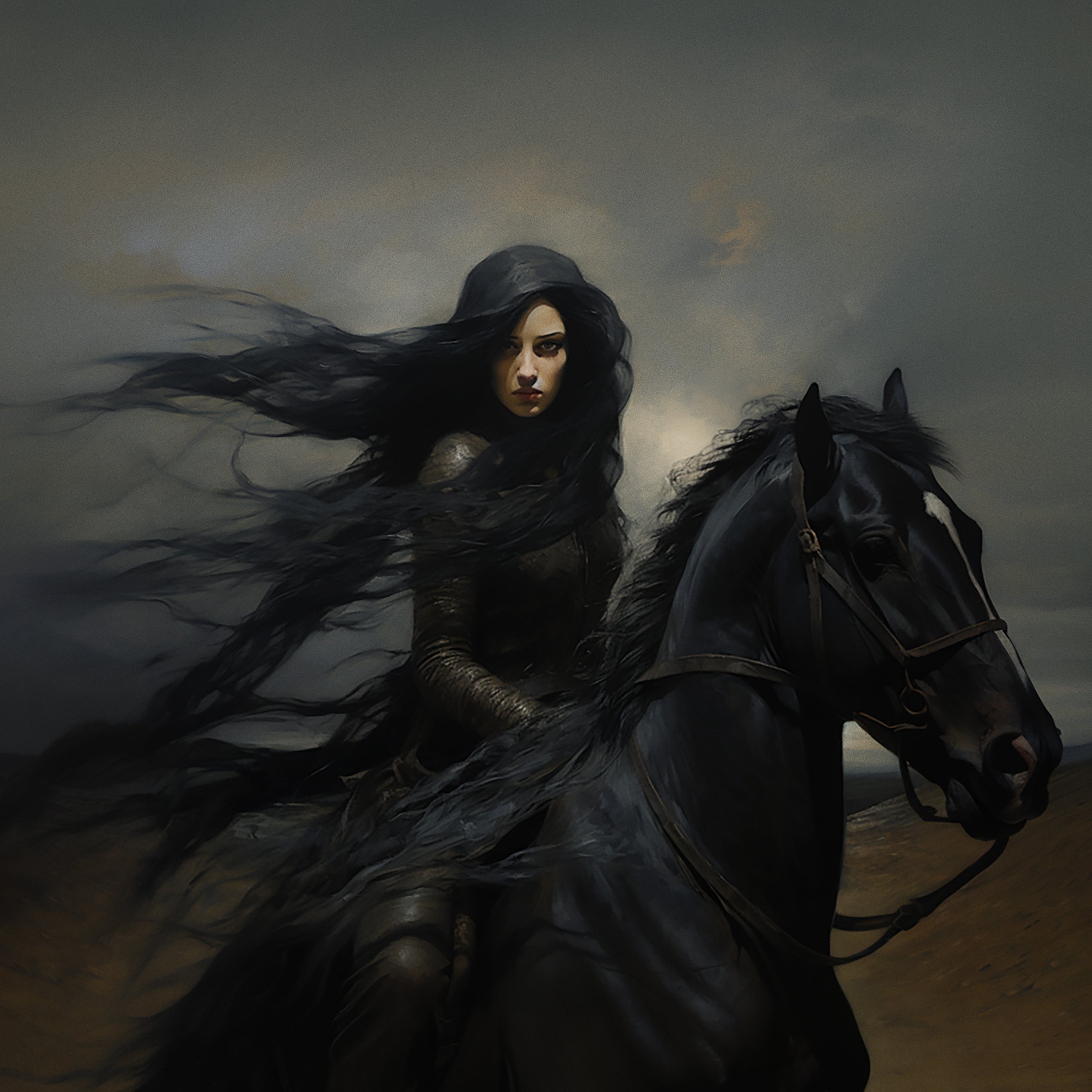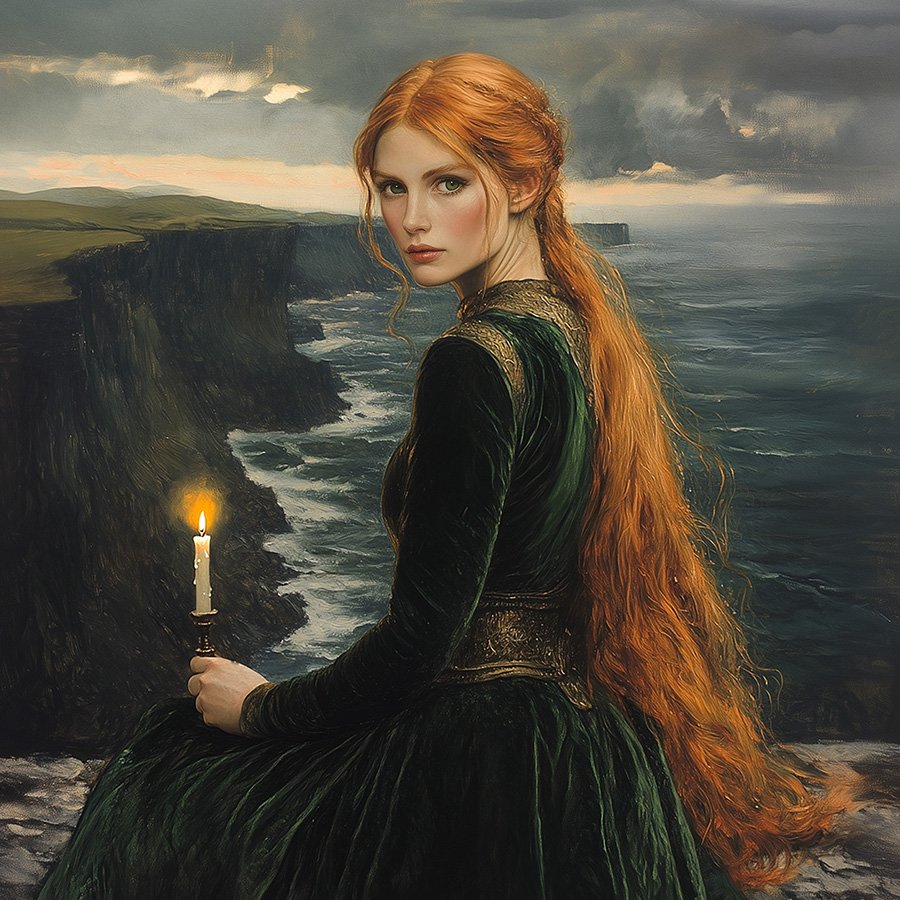Nyx
Nyx, the primordial goddess of night in Greek mythology, is a shadowy and majestic figure born from Chaos. She envelops the world in darkness, embodying the profound and hidden aspects of existence. As a divine mother, Nyx gave birth to significant deities like Eris and Nemesis, who influence cosmic balance and human affairs. Her realm and progeny reflect the complex interplay between light and darkness, and the mysteries of the human soul.
Hecate
As the season shifts to fall, we delve into the enigmatic realm of Hecate, a central figure in Greek mythology known for her profound influence over magic, crossroads, and transitions between life and death. Daughter of Titans Perses and Asteria, Hecate is depicted with three faces representing her dominion over the earthly, maritime, and celestial realms. Revered as a mistress of magic and arcane knowledge, she guided seekers of esoteric wisdom with her torches and protected against malevolent forces. Her lunar association and animal companions, the loyal dog and wise owl, highlight her role as a protector and guide in the mysterious aspects of existence.
Ishtar/Inanna
Originating from ancient Mesopotamia, the goddess Inanna—also known as Ishtar—embodies a rich tapestry of love, fertility, war, and the dynamic interplay between creation and destruction. Revered as the Queen of Heaven and Earth, she represents both strength and vulnerability, and her legendary descent into the Underworld symbolizes profound themes of transformation and renewal. With the lion as her sacred symbol, Inanna embodies the duality of the nurturing mother and fierce warrior, reflecting her protective and powerful nature. Her influence extends through various cultures, inspiring deities like Astarte and Aphrodite, and underscores her enduring legacy in spiritual narratives.
Virgo
The constellation Virgo, often associated with modern ideas of virginity is historical and mythological significant. Originally, Virgo’s symbolism was not about modesty but about independence and wisdom. This evolution from the ancient Sumerian goddess Nisaba, linked to writing and harvest, to the Mesopotamian deity Ishtar, representing fertility and love, highlights Virgo’s deep connection to themes of creation, balance, and transformation. Furthermore, Virgo’s ties to Demeter and Persephone reflect its association with agriculture, fertility, and the cycles of life and death, showcasing a multidimensional identity that transcends contemporary interpretations.
Lugh
Lugh, a central figure in Celtic mythology, is known for his diverse skills and attributes. As a member of the Tuatha Dé Danann and the grandson of the Fomorian leader Balor, Lugh's birth was prophesied to bring prosperity and overthrow his grandfather. His mastery across various disciplines—warfare, poetry, music, and druidic arts—earned him the title Samildánach, or Master of All Arts. Celebrated during Lughnasadh, his harvest festival in August, Lugh's legacy continues to inspire modern earth-centered spiritual practices, embodying light, knowledge, and creativity.
Ix Chel
Ixchel, the Jaguar Goddess of Maya mythology, embodies the lunar cycles and the dual forces of creation and destruction. As the Moon Goddess, she symbolizes birth, growth, and renewal, with a deep connection to fertility, healing, and rain. Her association with jaguars reflects her power and role as a guide for souls in the spiritual realm. Often depicted with a serpent-adorned headdress, Ixchel's presence underscores the Maya people's profound understanding of life’s interconnectedness and the natural world.
Tiamat
In ancient Mesopotamian mythology, Tiamat is a formidable deity representing primordial chaos and the cosmic ocean. As the mother of the first gods, she embodies the untamed forces from which the universe emerged. Her epic battle with the god Marduk, resulting in her defeat and the creation of the heavens and earth from her body, symbolizes the triumph of order over chaos. Tiamat's legacy endures as a potent symbol of the dynamic interplay between creation and destruction, influencing art, literature, and modern interpretations of myth.
Mawu
In the mystical realm of Dahomey mythology, the goddess Mawu emerges as a supreme figure of nurturing power and cosmic balance. Alongside her twin brother and husband, Lisa, Mawu represents the divine feminine, embodying the interplay between creation and destruction, light and darkness. As the mother of creation, she breathes life into the universe, nurturing the growth of plants and guiding natural cycles with her celestial influence. Mawu’s dominion over the moon and stars reflects her illuminating presence, symbolizing the rhythmic ebb and flow of life and the interconnected harmony of all living beings.
Freyja
Freyja, the Norse goddess of love, beauty, and fertility, holds a prominent place in ancient Norse mythology. Worshiped since the pre-Viking era, she is celebrated for her allure, magical prowess, and role as the leader of the Valkyries, guiding fallen heroes to the afterlife. Freyja is often depicted with a cloak of falcon feathers and a chariot drawn by large cats, symbolizing her connection to both the physical and spiritual realms. Her influence extends into modern culture, inspiring Norse-inspired art, literature, and contemporary pagan practices, where she remains a powerful symbol of feminine strength and sensuality.
Selene
Selene, the Greek goddess of the moon, was a Titaness and the daughter of Hyperion and Theia. She is often depicted with a lunar crown or crescent, driving her silver chariot across the night sky, illuminating the world with her soft glow. Known for her association with romance, Selene’s love story with the mortal Endymion symbolizes the eternal connection between the moon and desire. Revered in ancient Greece and continuing to inspire modern art and spiritual practices, Selene remains a potent symbol of the moon’s beauty and the mysteries of the night.
White Buffalo Calf Woman
White Buffalo Calf Woman, a revered figure in Lakota mythology, appeared to two hunters, marking a divine moment in their spiritual history. She imparted the sacred teachings of the Seven Sacred Rites and gifted the Lakota people with the Chanunpa, or Sacred Pipe, which symbolizes the connection between the human and the divine. Her teachings emphasized purity, respect, and unity, shaping essential spiritual practices within the Lakota tradition. The white buffalo, a manifestation of her presence, remains a powerful symbol of hope and renewal.
Pele
Pele, the revered goddess of fire, lightning, wind, and volcanoes in Hawaiian mythology, is a central figure residing in the Halemaʻumaʻu crater of Kīlauea on the Big Island of Hawaii. Born to the goddess Haumea and the god Kane Milohai, Pele's fiery journey began when she was cast out by her father after a dispute with her sister, the water goddess Namakaokaha'i. As she traveled across the Pacific and settled in Hawaii, she created the volcanic landscape and engaged in dramatic feuds, including a notable one with Namakaokaha'i that resulted in volcanic eruptions. Pele is celebrated for her powerful influence on the land, embodying both the destructive and creative forces of nature, and remains a symbol of strength and resilience in Hawaiian culture.
Ostara/Eostre
Ostara, also known as Eostre, was a pivotal figure in ancient Germanic spirituality, representing the arrival of spring and the rebirth of life after winter. Her name, derived from "ostarun," meaning "eastern direction," reflects her association with the dawn and the renewal of light. Symbolized by hares and eggs, Ostara embodied fertility and the promise of new beginnings. Her ancient festival, celebrating the spring equinox, laid the groundwork for modern Easter traditions, illustrating her enduring influence on seasonal celebrations.
Olwen
In Welsh mythology, Olwen is a goddess of beauty, purity, and renewal, her very presence said to cause flowers to bloom in her footsteps. Her name, meaning "white track" or "white footprint," reflects her connection to spring and the natural world's rejuvenation. The tale of her courtship by Culhwch, who must complete formidable tasks to win her hand, underscores her association with the cycles of life and the challenges that lead to growth. Olwen remains a symbol of nature's vitality and the importance of honoring the earth's beauty and abundance.
Brigid
Brigid, a central figure in Celtic mythology, is revered as the goddess of fertility, healing, poetry, and smithcraft. Originating from ancient Ireland, she was celebrated as a bringer of spring and a symbol of renewal, her presence marked by the sacred flame tended in her temple at Kildare. Brigid's influence extended beyond her associations with fertility and healing to her role as a patron of the arts and crafts, inspiring both poets and metalworkers. Despite the rise of Christianity, Brigid's worship endures, with her festival Imbolc, celebrated on February 1st, reflecting themes of growth and new beginnings, and her legacy continues to inspire modern practitioners of Celtic spirituality.

















